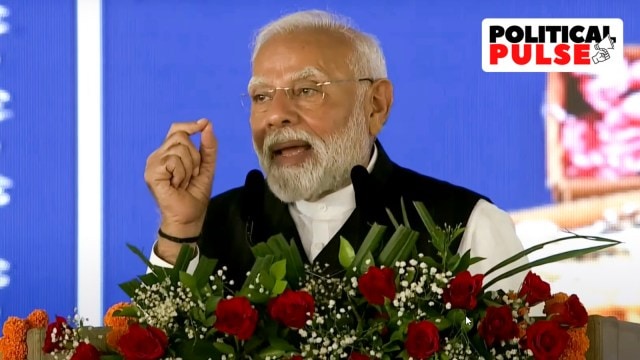The Unified Pension Scheme (UPS) announced on Saturday is the Narendra Modi government’s biggest outreach to Central government servants yet, and also to a small section of the salaried middle class that has Central government jobs or aspires to hold one.
Kicking in from the next fiscal, the scheme guarantees government employees 50% of their average basic pay drawn over the last year of service as pension, alongside increasing Dearness Allowance (DA) benefits over time. UPS will now be an available option for employees who joined the service in 2004 or later, though the existing National Pension Scheme (NPS) will also remain an option. NPS requires a 10% contribution from the employee’s basic salary, with the government contributing 14%. Under UPS, the government’s contribution will increase to 18.5% though Central government employees will continue to contribute 10% of their basic pay and DA.

With the benefits available only to 23 lakh Central government employees, the government has reached out to those largely in the bureaucracy. However, the move also provides a template for state governments, Central universities set up by Acts of Parliament, and public sector units (PSUs) to follow in the coming years.
Known for carving out a constituency among the poor with highly publicised initiatives such as free 5-kg foodgrains for 80 crore families, houses and gas cylinders for the poor, the Modi government has for the first time offered a major relief to the section of the middle class in government jobs even as private sector employees have not had much to cheer about in the last 10 years. With this, a welfare-oriented government extending welfare measures beyond the poor has been inaugurated.
This move has some parallels with the tenure of the Congress during which government salaries were significantly hiked by the Sixth Pay Commission. The Congress-led UPA government was also known to change Income Tax slabs frequently to provide relief to the salaried middle class, something that the present government has not done to the same extent.
On Sunday, Congress president Mallikarjun Kharge took a dig at the Centre, saying, “The ‘U’ in UPS stands for Modi Govt’s U turns! Post June 4, the power of the people has prevailed over the arrogance of power of the Prime Minister. Rollback in the budget regarding Long Term Capital Gain / Indexation; Sending Waqf Bill to JPC; Rollback of Broadcast Bill; Rollback of Lateral Entry. We will keep ensuring accountability and protect 140 Cr Indians from this despotic government!”
While the choice of Cabinet ministers and Speaker suggest that PM Modi wants to send a message of continuity, some recent government decisions show that the BJP is far more sensitive about how it is being perceived after dropping 63 seats in the Lok Sabha elections. BJP’s Ravi Shankar Prasad shot back at the Congress, saying, “I want to ask Rahul Gandhi — has his government implemented the Old Pension Scheme as promised in Himachal Pradesh? The Congress party has become so wary of the palpable falsehood of its assurance about pension that it could not muster the courage to include that as a part of its manifesto in the Lok Sabha elections.”
Story continues below this ad
During the Assembly elections of Himachal Pradesh, Madhya Pradesh, Chhattisgarh, and Rajasthan in the last two years, the Congress promised a return to the Old Pension Scheme (OPS) but gave it a miss in its Lok Sabha manifesto. While UPS is not the same as OPS, its benefits for retiring employees are being seen as closer to it.
Congress’s allegations
The Congress has alleged many times that some of the moves of the BJP in recent months have been in “imitation” of its promises. After Union Finance Minister Nirmala Sitharaman presented the Budget, Leader of the Opposition in the Lok Sabha Rahul Gandhi labelled the exercise “copy and paste (of) Congress manifesto” and previous Budgets.
In the interim Budget ahead of the Lok Sabha polls, which the BJP expected to sweep, the word “employment” appeared seven times and “job” once. A few months down the line, the Budget speech saw the words “job and employment” feature eight and 34 times, respectively, including in subheadings. Sitharaman also announced three “Employment Linked Incentive” schemes, apart from internship opportunities in 500 top companies for one crore youths over five years.
Apart from jobs, Sitharaman began her Budget speech by talking about MSMEs and went on to refer to them 21 times in her speech. Again, the Congress was quick to point out that a helping hand to the MSMEs — struggling under the successive blows of demonetisation, GST, and Covid-19 — was another key issue for the Opposition during the elections.
Story continues below this ad
The Congress said after the Budget that the Modi government appeared to have borrowed its ideas from its Lok Sabha poll manifesto, starting with the scheme to provide internship opportunities to youth. The Congress manifesto had promised a “right to apprenticeship programme”, which Gandhi referred to in his campaign speeches as the “Pehli naukri pakki (guaranteed first job)” scheme.
Another Congress promise was to “create a new employment-linked incentive (ELI) Scheme for corporates”. The party said the Budget’s announcement of three employment-linked schemes, including one under which the government will provide one month’s wage to those entering the workforce in all sectors, was similar to this.
Yet another Budget promise, of setting up working women hostels to promote their participation in the workforce, had also found a mention in the Congress manifesto. The Congress also claimed credit for the Budget proposing the abolition of angel tax for all classes of investors. The party saw the announcement of a critical mineral mission as a reflection of another of its manifesto promises.
On the “parallels” between the manifesto and Budget, former Union Finance Minister and senior Congress leader P Chidambaram has said: “I wish she (Sitharaman) had adopted many more ideas from the Congress’s manifesto.”

































